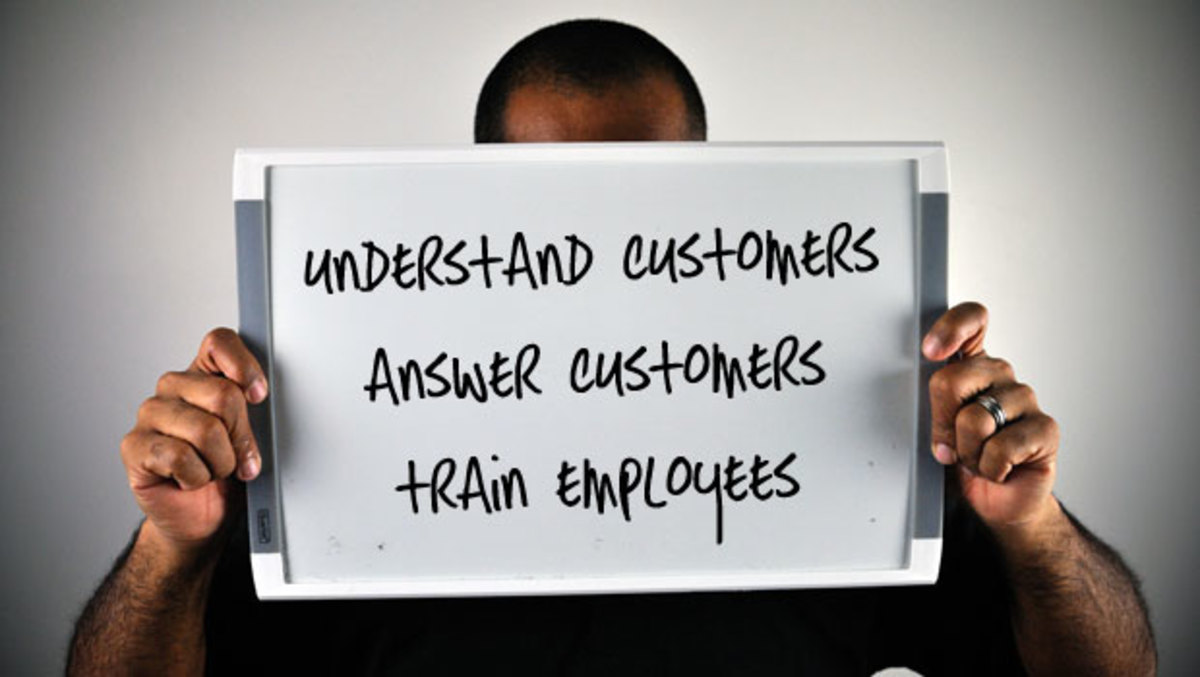How to Handle the Angry Customer
Help this guy to win

Customer Relations and More
An Irate Customer can be a Marketing Opportunity
Sometimes you screw up. Sometimes there is a misunderstanding between your company and your customer; sometimes your product or service doesn’t work as it should; sometimes one of your employees may have been abrupt; and sometimes your customer or client may have gotten out of the wrong side of the bed that morning, and you’re going to pay for it! The point here is that sometimes, not often, one of your customers is going to be angry about something. The way you handle this situation, and the way you train your employees for encounters like these, is one of those critical areas where you earn the title manager.
When a customer is upset, always assume that the situation can go from a spark to a forest fire, and act accordingly. We human beings like to be right. If you tell me that I did something wrong, my first inclination is to prove to you that I did not, or to rationalize the problem by explaining that my apparent wrongness was really right. When we lapse into this basic survival instinct, we become our inner child; in other words, we act like five-year-olds. One could argue that a key to successful adulthood is getting this tendency under control. Assuming that your customers are human beings, you can assume that they, too, like to be right. So, consider the situation in which your angry customer is convinced that he or she is right and your natural inclination is to also be right. You need to fight this natural inclination. Your only hope for a successful outcome is to stop yourself short, shift away from your basic instinct to defend yourself, and be an adult. Let’s break down the “irate customer event” into its basic components:
The customer needs to win, and you need to figure out how. The fundamental rule of negotiating is this: the outcome needs to be a win-win. Only a fool assumes he must drive a bargain where only he comes out on top. Your mind-set, when dealing with the angry customer, has to be, “How can I make this situation a winner for this person?” You may be asking yourself, “But how is this a win-win situation if I’m only supposed to be concerned about the other person winning?” The answer is simple: you win by keeping a customer relationship, and probably even enhancing it. That’s where the win-win comes in.
A battle you cannot win. If there is one thing you need to drill into your employees, as well as yourself, it is this: when an angry customer wants to argue, you might be able to win the argument with facts and logic, but you lose in the long run because that customer has likely become a noncustomer at best, or a “dark legend spreader” at worst. In the Internet age word spreads fast, and many use it as a tool of revenge. You do not want to come across a website entitled yourcompanysucks,com. Consider the samurai warrior. Samurai were famously courageous in battle because they assumed they were going to die. When dealing with the angry customer, assume you are going to lose the argument and win the battle of keeping a customer.
You must be calm. Understand that your angry customer is busy expressing his inner five- year-old. If you let out yourfive-year-old to argue with his 5-year old, you have blown it, and you may as well arrange for a sit-down meeting in a sandbox. It is not easy to be calm in the face of anger. The way to do it is to focus completely on his or her problem. The customer is angry for a reason, whether real or imagined, appropriate or not, and your job is to root out the problem and look for the solution.
Use emotional judo. In the martial art of judo or jiu-jitsu, one uses the weight, force and strength of an opponent against him. That’s how a little gal, skilled in judo, can fling a big guy across a room. Now this analogy can go only so far: it’s not suggested that you start throwing customers around the room. But it is close enough to the real-life way that you can confront a charging opponent without a direct clash.
The Charging Bull and the Pussycat
Consider this example of how to use emotional judo to calm the angry customer. Assume that you run a business research company. Your day is going just fine when you get a call from the research department and you are told: “Joe, there’s a Mr. Smith on line one, and he’s really upset about the research report we did for him last week.” The first thing to ask is “What’s his first name?” (This is crucial. It’s much easier to deal with Bob Angry than Mr. Angry.) Then use a simple ideation technique: envision the caller to be a close friend for whom you would do anything. In reality, he might be the most miserable creep on the planet, but your mental ideation will control your voice when you pick up the phone. Next, ask the person who passed the call to you for a very brief summary of what he is angry about. Now here’s the key: always pick up the phone and say something like: “Hi Bob, this is Joe. Did we screw something up?” Now get the picture here. Bob has a bone to pick. He assembled all his facts in logical order, prepared his argument, and was ready to do battle with his opponent (you). Instead, what does he get? Your friendly voice and an attitudeshowing that you’re basically rolling over and playing dead. The response from Bob Angry will usually be: “Oh, I wouldn’t say you screwed up. Maybe I wasn’t very clear when I placed my request.” Now here is a guy who wanted to kill you and your company a few minutes before and is now he’s saying that maybe it was his fault. After determining what you need to do to send him the correct report, offer to ship it overnight—at your cost. By the time you get off the phone, Bob Angry has become Bob Buddy. He is no longer a charging bull; he has become a pussycat, and all he wants to do is lick your ear.
But what if the mistake was really the customer’s? So what? His perception was that it was your mistake, and no amount of persuasion would get him to admit that he was wrong. So why try.
Customer Relations 101

It’s the Relationship Stupid
In this example, you may have lost a sale, or at least sacrificed the time and money it took your employees to do the work. But what you really did was to let the customer win and in so doing you preserved the most important part of the transaction—the customer relationship. You have probably gone even further; you have enhanced his opinion of you and your company. Customer relationships should be a prominent part of your business plan.
The angry customer is a marketing opportunity.
The writer of the article is the author of The APT Principle: The Business Plan that You Carry in Your Head, from which this article is excerpted.
Copyright © 2013 by Russell F. Moran





